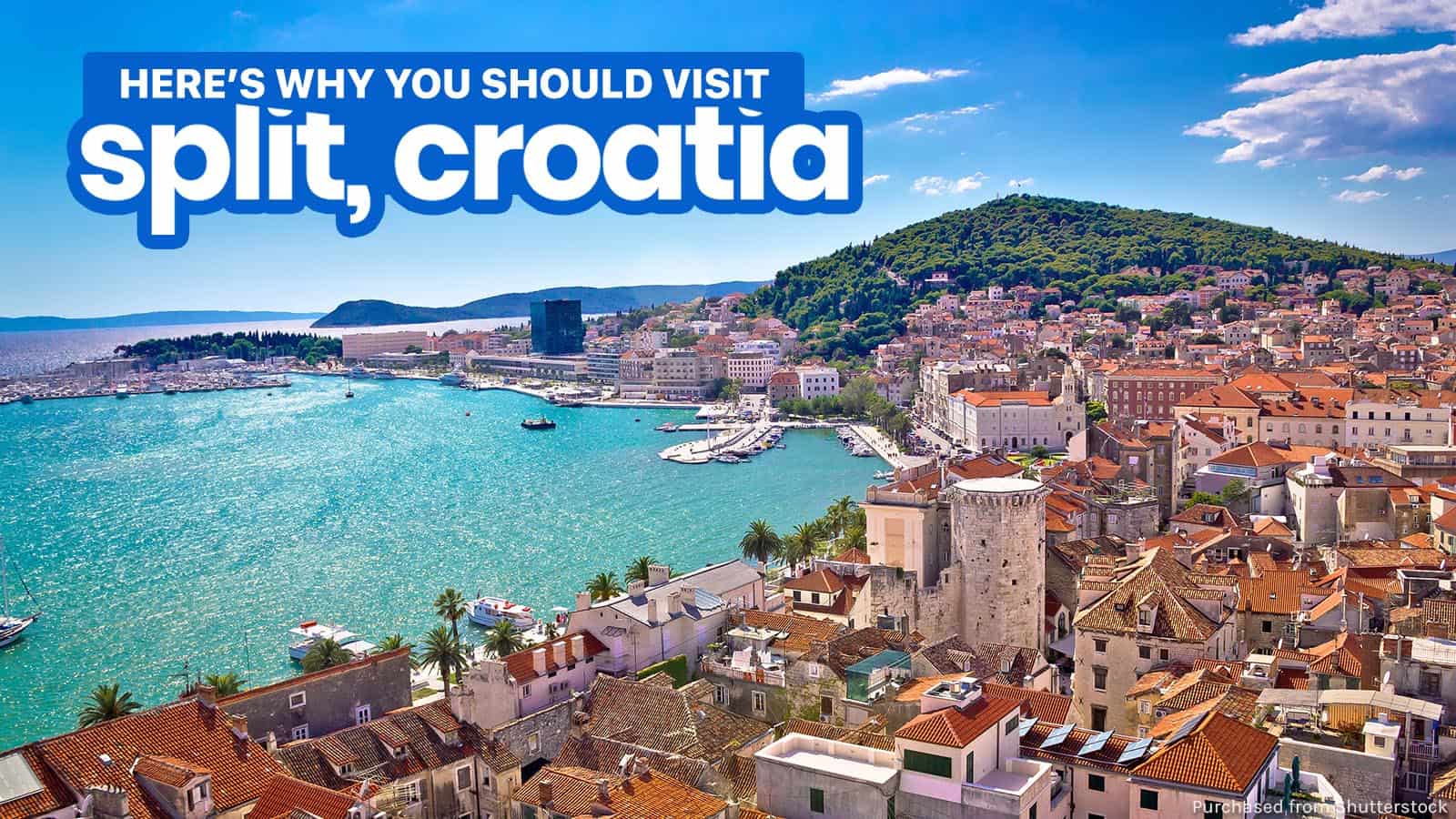The city of Split is nestled on a peninsula sandwiched by the Gulf of Kaštela and the Split Channel. Within the city, natural and man-made attractions abound, from Marjan Hill’s pine forest to the Diocletian Palace. The city center is dominated by the vast ancient palace complex, giving a glimpse of its storied past through the historical landmarks and sites.
Split is also a good base to explore nearby cities within the Central Dalmatia region. You can access two national parks — one with many majestic waterfalls and the other with exquisite lakes. If you suddenly crave some fun in the sun, you can easily hop to one of the nearby islands peppering the eastern side of the Adriatic Sea.
If you are planning to visit Split, here are the best things to do and places to visit. We also included day trip destinations that are easily accessible from Split. We also provided links if you are interested in booking guided tours and skip-the-line tickets. Rates and fares vary per season. Prices go high in peak season; that is during summer months — from June to September.
1. Diocletian’s Palace Walking Tour
The old city of Split was built around the 4th-century Diocletian’s Palace, a historic icon commissioned by the former Roman emperor, Diocletian, as his retirement residence. Today, it occupies almost half of Split’s old city area. The vast property features ancient walls or fortresses and a military garrison. It is recognized by UNESCO as a World Heritage Site since 1979.
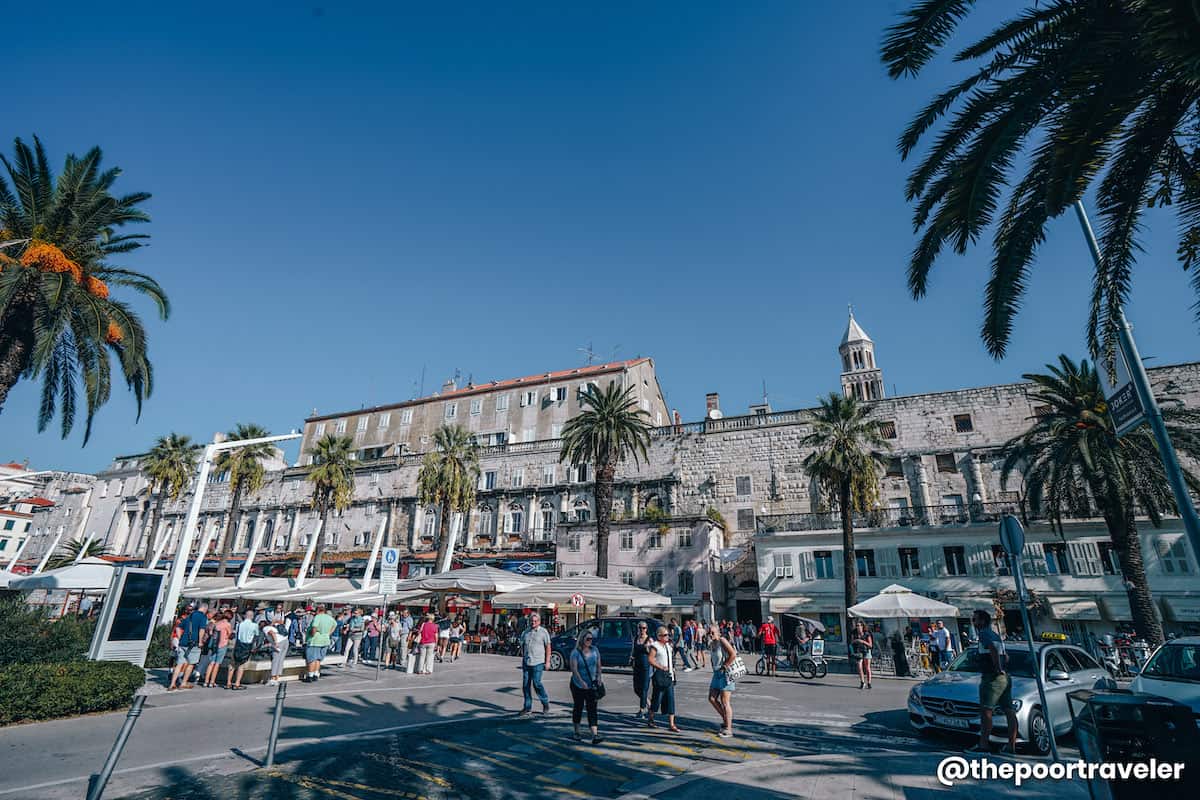
Entrance Fee: FREE; KN 40 (Palace Basement). If you want to enter the buildings inside the palace complex, some require entrance fees.
Opening Hours: The palace complex is part of the old city, so it’s open 24/7. The buildings within the complex have varying opening and closing times.
Nearest Bus Stop: Split Stop (Leo Express Buses). This is near the city harbor.
If you want to tackle the key attractions and landmarks in Split with insights from a knowledgeable person, you can book a guided walking tour.
2. Krka National Park
Declared a national park in 1985, Krka National Park is an important ecological, cultural, and tourism site. It covers 109 square kilometers of protected land that is home to several endemic species of flora and fauna. Straddling the Krka River in the Central Dalmatia region, the park’s crowning glory is the series of seven waterfalls.
Located in the north is Roški Slap, a waterfall surrounded by walking paths and viewing spots. Situated in the south is the most famous waterfall within the park, Skradinski Buk. It features a vast natural pool and smaller cascades aside from the main waterfall. There are also walking trails and viewing spots.
Another tourist attraction is the Visovac Island, which houses a 15th-century Franciscan monastery. The centuries-old Krka Monastery is also a noteworthy destination. It is located north of Roški Slap.
Entrance Fee: KN 30 (January – March, November – December); KN 100 (April – May & October); KN 200 (June – September). These rates are for adults. From ages seven to eighteen, the rates are KN 20/KN 80/KN 120. Children seven years old and below are free of charge. The fee includes access to all land sites in the Krka National Park.
Opening Hours: Skradinski Buk follows a different schedule. It is open all year round, while other sites are CLOSED during winter months (January – March, November – December). Skradinski Buk starts operation at 9AM during the winter season, 8AM outside the winter season. Closing time varies from 4PM to 8PM. Other sites open at 10AM and close at 5-6:30PM from April to October.
Getting There: There are five entrances to the park — Skradin, Lozovac, Roski Slap/Laskovica, Burnum/Puljane, and Kistanje/Krka Monastery. There are direct bus routes from Split to Skradin. The travel time is 1.5-2 hours. The fare is KN 65 – KN 75.
You can check this day tour to Krka National Park from Split. This is inclusive of roundtrip transfers, onboard WiFi, an English-speaking guide, a bottle of water, and insurance. If you want a hassle-free transfer, you can book this tour.
3. Game of Thrones Tour

Croatia is one of the countries where Game of Thrones filmed some of their memorable scenes. Some of the chosen locations were Split’s remarkable streets, the cellars, and the underground area. Explore the Fortress of Klis, featured in the hit HBO series as the city of Meereen, and discover where Daenerys’s dragons were kept.
Several companies offer a Game of Thrones tour package. If you want to reserve your slot in advance, you can do it online. The usual inclusions are transportation between Klis and Split, entrance fees (Fortress Klis and Diocletian’s Palace), an English-speaking guide, and insurance.
4. Sibenik
Sibenik, the third-largest city in the Central Dalmatia region, is located northeast of Split and south of Krka National Park. This coastal city is also the main gateway to the Kornati archipelago, which is composed of 150 islands and is located west of Sibenik.
The oldest native Croatian city along the Adriatic Sea, the city is home to many ancient cultural and historical landmarks, including two UNESCO World Heritage Sites — the Cathedral of St. James at the city center and St. Nicholas Fortress on an island. There are three more historic fortresses in Sibenik aside from St. Nicholas: St. Michael’s Fortress, St.John Fortress, and Barone Fortress. The city also has beaches, resorts, restaurants, and bars.
Nearest Bus Stop: Sibenik Bus Terminal
Fare: The bus fare is KN 45 – KN 55.
Getting There: Buses are the fastest and most convenient mode of transportation to Sibenik from Split. If you are taking the train, you need to change trains at Perkovic and may take 2.5 hours. The fare is cheaper when you take the bus. There are direct bus routes from Split to Sibenik. The travel time is about 1.5 hours.
If you want to visit both Sibenik and Krka National Park, there are companies that offer this tour. Below is a package from Split. This includes roundtrip transportation, Krka National Park entrance fee, a professional guide, insurance, and a bottle of water.
5. Island Hopping
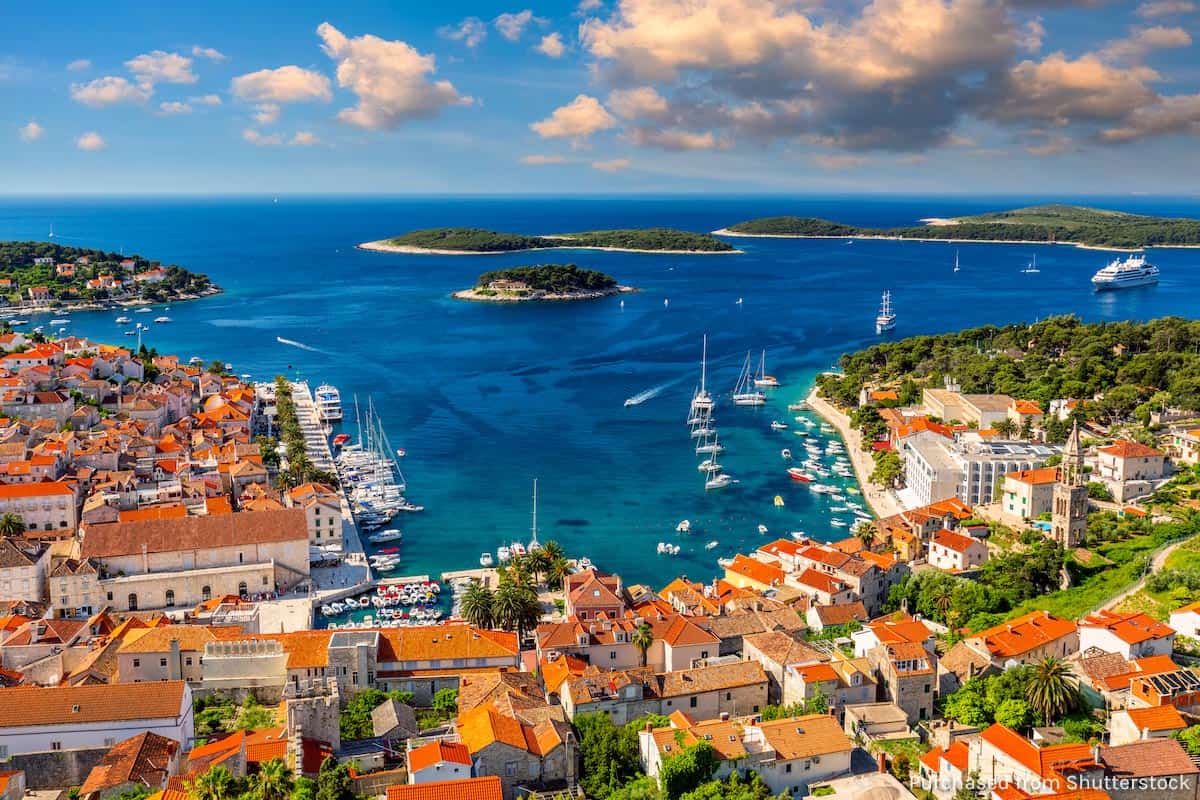
The eastern side of the Adriatic Sea, just off the coast of Croatia, is specked with islets. This archipelago is under the jurisdiction of the Dalmatia region. Here are some of them:
- Biševo Island (Blue Cave)
- Hvar Island
- Vis Island
- Budikovac Island (Blue Lagoon)
- Pakleni Islands
You can easily reach many of these island destinations from Split. If you build your itinerary well, you can visit independently. If you don’t want to be bothered with the planning, you may simply join a guided island hopping tour.
You can book the tour below. This is inclusive of the following:
- Speedboat transfer between the islands
- An English speaking captain and the crew
- Windproof jackets
- Snorkeling equipment
- Onboard soft drink
- Insurance
6. Riva Harbor
Riva Harbor is abuzz with activities any time of the day — morning, afternoon, and evening. The wide tree-lined boardwalk spans between Vodoskok Fountain and the Bronze Gate. The lively promenade, lined with hip restaurants and cafés, is a favorite meeting place for locals and tourists alike. It caters to morning joggers, afternoon sunset watchers, and evening revelers. It is also a good setting off point for those who want to explore Marjan Forest Park. Other nearby landmarks are Diocletian’s Palace and Saint Domnius Cathedral.
Entrance Fee: FREE
Opening Hours: 24/7
Nearest Bus Stop: Riva Stop (Bus 12) or Split Stop (Leo Express Buses)
7. Pjaca Clock Tower
Dominating the eastern side of the Pjaca (People’s Square), the centuries-old tower, adjacent to the age-old western gate of the Diocletian’s Palace, hosts an old bell and the ancient city clock. Aside from its high location, what makes the clock stand out is its peculiar 24 digits numbering instead of only 12. By the way, the clock is still ticking up to this day. You can climb up to the tower to get a panoramic view of the People’s Square and the Riva Harbor.
Entrance Fee: KN 20
Opening Hours: The opening schedule varies.
Nearest Bus Stop: Riva Stop (Bus 12) or Split Stop (Leo Express Buses)
8. Plitvice Lakes National Park
Located in the mountainous region of Central Croatia, Plitvice Lakes National Park will overwhelm you with stunning views and natural wonders. Being one of the largest and oldest national parks in Croatia, it offers numerous hiking trails for both beginners and hardcore hikers.
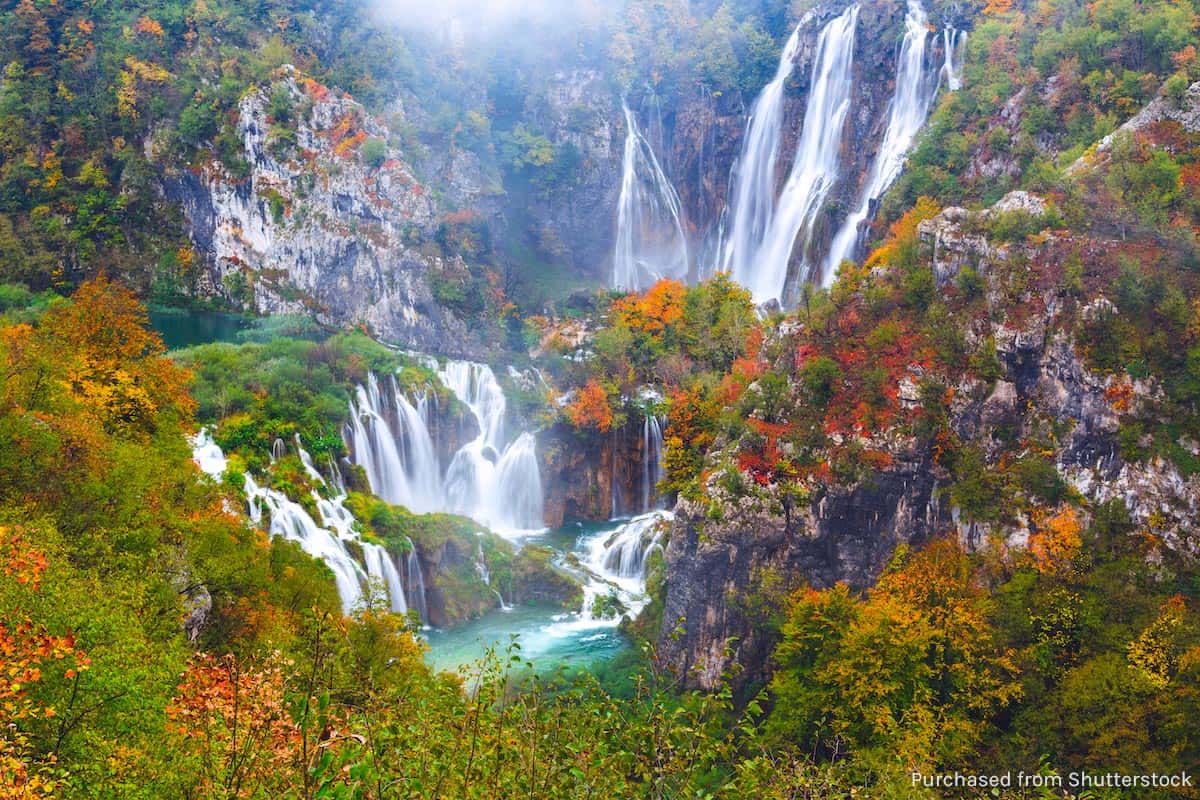
The vast, lush alpine forests are scribbled with caves, lakes, rivers, and waterfalls. But the highlight is the lake terraces formed by sixteen lakes, flowing from top to bottom, forming magnificent waterfalls. The highest among these falls is the 78-meter-high Veliki Slap.
Visitors can traverse and explore the lakes and the falls through the walkways snaking around and through the waters. Each lake and waterfall has its own stories and legends. Founded in 1949, it is further protected when it is recognized by UNESCO as a World Heritage Site in 1979.
Entrance Fee: KN 80 (January – March, November – December); KN 180 (April – May & October); KN 300 (June – September). These rates are for adults. Children from seven to seventeen years old get less than half of the rates for adults. Children under seven years old are free of charge.
Opening Hours: 8AM – 4PM (October – March), 8AM – 7PM (March – May), 7AM – 8PM (June – 20 August), 7AM – 7PM (21 August – September). Note that last entry, ticket purchase, and exchanging vouchers are done TWO HOURS BEFORE closing time.
Getting There: From Split, go to the main bus terminal near the port and board a bus bound for Plitvice Lakes. There are direct routes offered from Split. The travel time is 3-4 hours. The fare is KN 135 – KN 175.
If you want to travel conveniently and learn more insights and stories about the lakes, you can book a guided tour online ahead of time.
9. Cetina River Rafting
Flowing from the alluring springs in the northwestern slopes of Mount Dinara, Cetina River snakes through cities and towns in the Dalmatia region before it enters the Adriatic Sea. For the adventurous, a thrilling way to explore and go sightseeing is through a rafting experience on the Cetina River.
Get your adrenaline pumping as you course through the river, basking in the raw beauty of nature enveloping you and taking your breath away. You can also stop for a while and take a short swim.
Cetina River Rafting tours are offered by operators from Split. This one has a package that includes roundtrip transfers, certified professional instructor, safety briefing, insurance, and full rafting equipment — wetsuit, life jackets, helmets. neoprene shoes, and paddles. The activity lasts for about six hours.
10. Cetina River Canyoning
This is another level of extreme. Canyoning is like a mixture of hiking, cliff-diving, and rappelling. If you are not afraid of heights and into a thrilling outdoor experience, canyoning is the best way to immerse yourself in Croatian nature. Enjoy the view as your scale the canyon and cliffs. Scream your heart out as you splash and slide your way through clear waters.
You’ll find canyoning tour package from Split to Cetina online. The usual inclusions are roundtrip transfers, safety briefing, a certified professional instructor, insurance, and full canyoning gear — wetsuits, life jackets, and helmets.
11. St. Duje’s Cathedral (Cathedral of Saint Domnius)
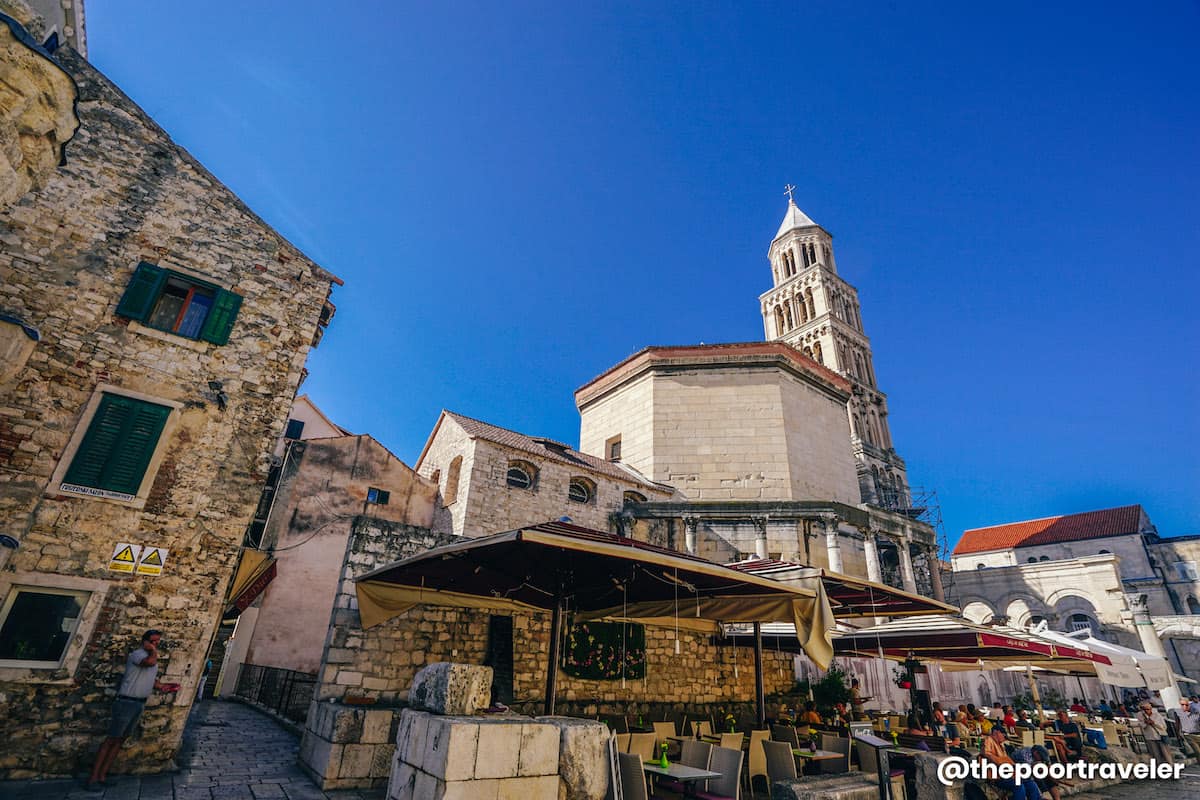
The 4th-century Cathedral of Saint Domnius is said to be the world’s oldest functioning Catholic cathedral that retains its original structure. Located inside the Diocletian’s Palace complex, it was actually a mausoleum built for the emperor. Over the years, the choir and the bell tower were added, forming the cathedral complex.
While the church is dedicated to the Virgin Mary, the 60-meter bell tower is dedicated to Saint Domnius, Split’s patron saint. The cathedral also features a treasury that hosts the relics of Saint Domnius.
Entrance Fee:KN 35 (Cathedral + Treasury + Crypt + Baptistery), KN 20 (Bell Tower)
Opening Hours: 7:00 AM – 9:00 PM (Daily). Note that opening hours may change, so check first before going.
Nearest Bus Stop: Split Stop (Leo Express Buses). This is near the city harbor.
12. The Campanile
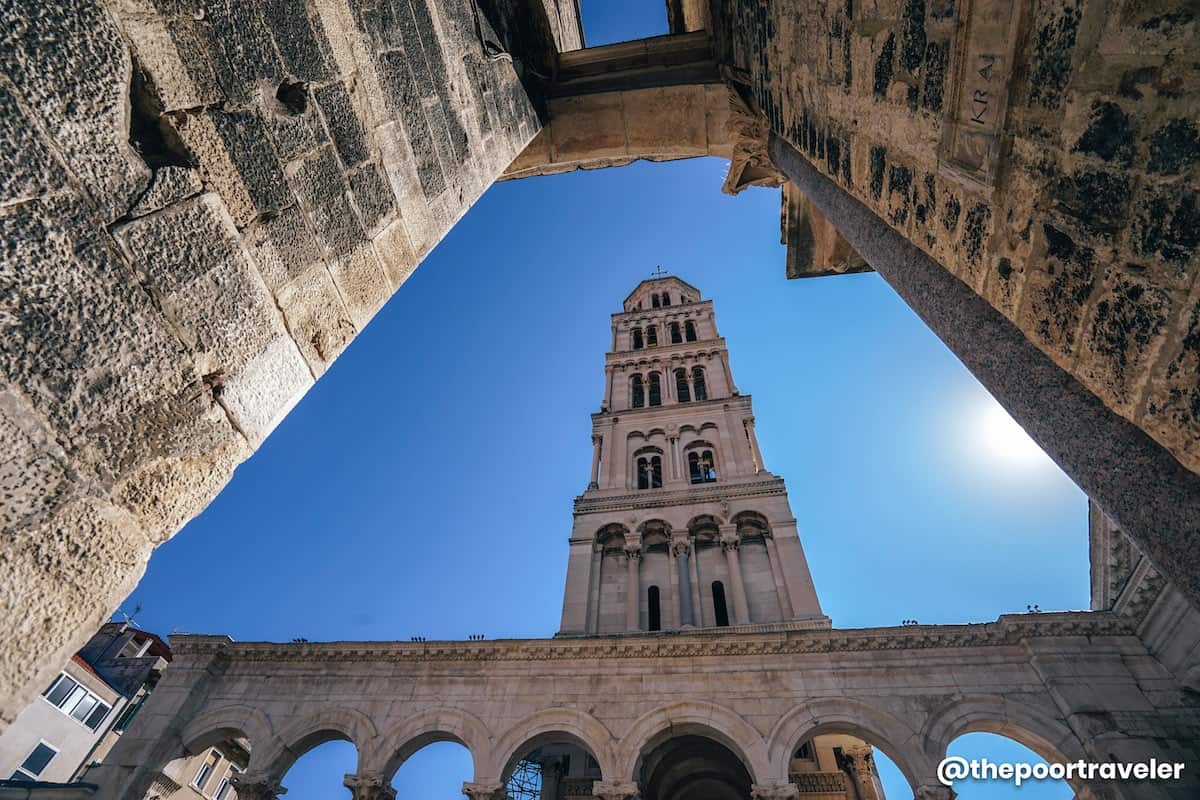
The medieval bell tower is one of the most important landmarks in Split. It reflects Gothic and Romanesque styles of architecture.
But apart from history and architecture, it boasts a spectacular panoramic view of the city and the harbor. Conquer almost 200 steps up the tower for a natural high. Good news for those visiting soon because it recently reopened this 2020 after a two-year renovation.
Entrance Fee: KN 20
Opening Hours: 8:00 AM – 7:00 PM (Monday – Saturday), 12:30 PM – 6:30 PM (Sunday). Note that opening hours may change, so check first before going.
Nearest Bus Stop: Split Stop (Leo Express Buses). This is near the city harbor.
13. Food Trip
The coastal areas’ types of cuisine are quite different from those in the mainland. Since Split is a coastal city, it’s largely based on the Mediterranean diet, which uses fresh and light ingredients. Expect seafood (especially fish), vegetables, olive oil, and lots of herbs like sage, rosemary, oregano, and other light spices.
There are many dining places within and around the palace complex. Here are some of the budget-friendly establishments we have tried:
- Buffet Zlatna Ribica. We ordered a plate of squid and sardines. Great with beer.
- Misto Street Food. It may be street food, but it’s a bit elevated. We had better food here than at most other sit-down restaurants in the area. Ordered bruschetta dalmatina, grilled tuna salad, and dalmatian pork pasticada. They were all delicious and filling.
- Vege Fast Food. A vegan hole-in-the-wall type of eatery, surrounded by shops outside the palace complex. It gave us one of our best meals in the city. We had quinoa with grilled vegetables and basmati rice with tomato sauce. Generous servings, good for 2!
14. Peristil Square
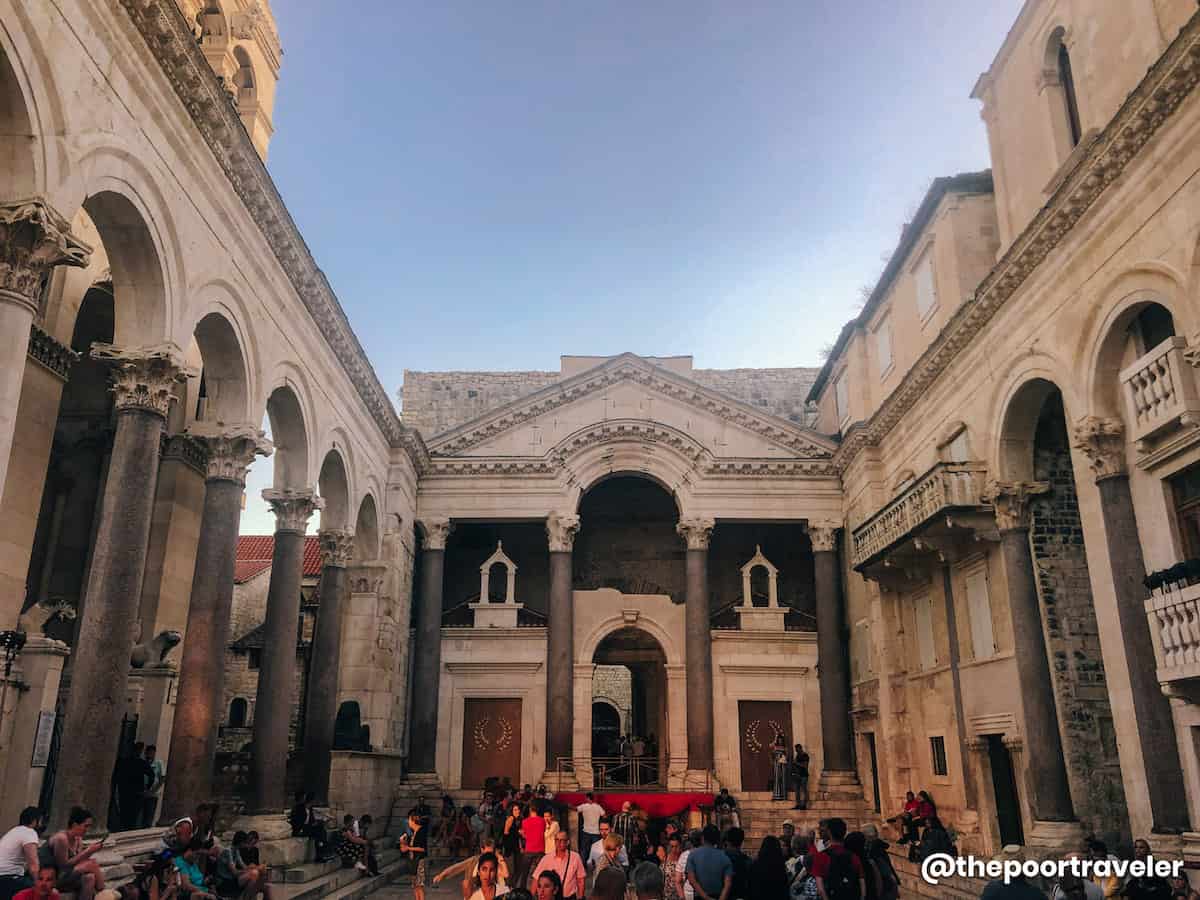
Peristil, sometimes spelled Peristyle, is originally the palace courtyard of Diocletian’s Palace where imperial guests were welcomed and received before being ushered to the palace hall. Diocletian used to hold public addresses here.
Today, it functions as a city square inside the palace complex. The square is dominated by the towering bell tower of the Cathedral of Saint Domnius and surrounded by ancient porticoes. The area is also teeming with shops, restaurants, and bars. The square leads to Split Harbor.
Entrance Fee: FREE
Opening Hours: 24/7
Nearest Bus Stop: Split Stop (Leo Express Buses). This is near the city harbor.
15. Museum of Senses
Located on the easter portion of the peninsula where the city lies, the Museum of Senses will literally awaken your senses through its interactive exhibits and walk-in installations.
The museum has over 50 different attractions that will stimulate your sense of sight, hearing, smell, touch, and balance. Some of the attractions include Mysterious Objects, Optical Illusions, Disco Galaxy, Sound Cubes, The Night Room, The Smelliest of Smells, Laser Harp, and Four Winds among others.
Entrance Fee: KN 25 (Adults), KN 15 (5-15 y/o), KN 20 (Reduced)
Opening Hours: 9:00 AM – 10:00 PM (Saturday & Sunday)
Nearest Bus Stop: City Center One Stop (Bus 18, 3, 6). The museum is located inside the mall.
If you don’t want to wait in line, you can book your ticket in advance online. You can reserve and get your skip-the-line ticket online, too!
✅ GET SKIP-THE-LINE TICKET HERE!
16. Grgur Ninski Statue
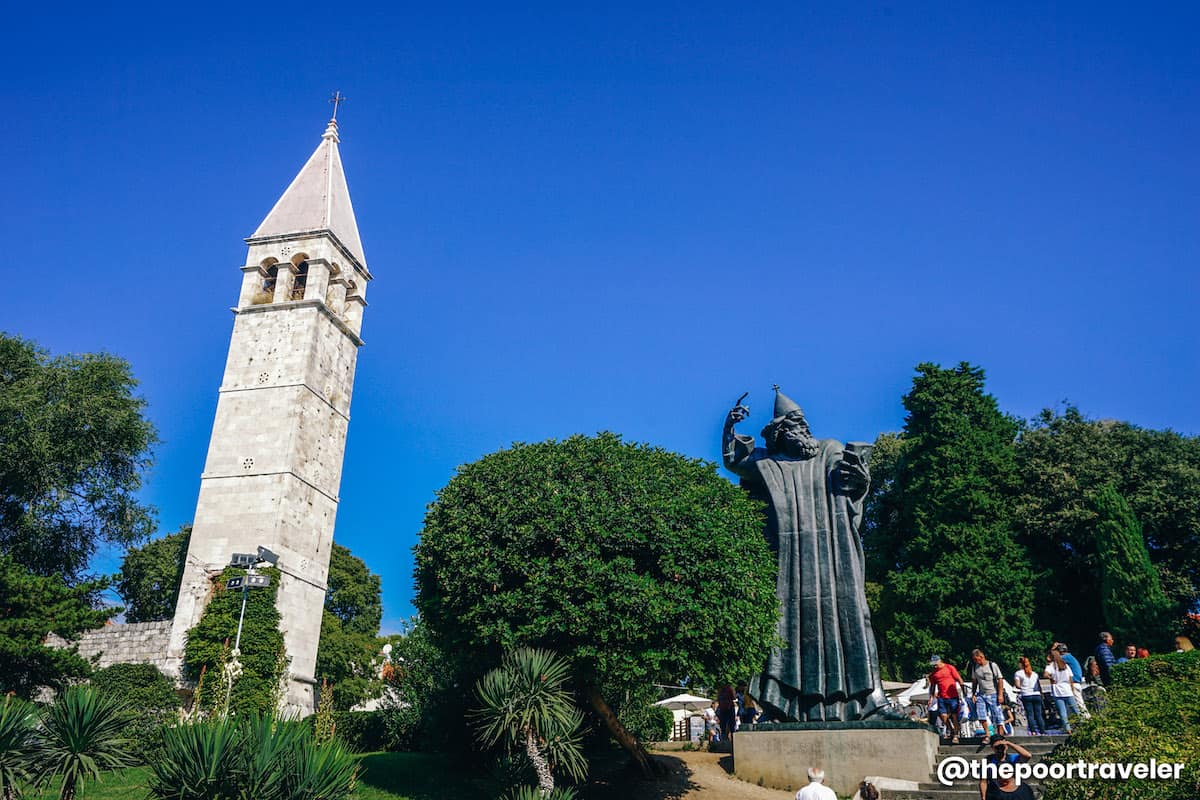
The Gregory of Nin Statue is an important historical monument in Split. It was erected in 1929 by Croatian sculptor Ivan Meštrović in honor of the medieval bishop, Gregory of Nin, who championed the Croatian language to be used in Catholic services in Croatia instead of Latin.
Its current location is actually the third site. It was originally placed in Peristil Square before it was moved outside the city in 1941. Finally, it was moved again in 1954 to where it is now — near the Golden Gate, north of the palace complex.
You might notice that the toe of this colossal statue’s left foot is smoother and shinier compared to other parts of the structure. The reason is that many believe that rubbing the toe of the left foot will bring them good luck and happiness.
Entrance Fee: FREE
Opening Hours: 24/7
Nearest Bus Stop: Split Stop (Leo Express Buses). This is near the city harbor.
17. Marjan Forest Park
Dominating the western portion of the peninsula is the vast, forested Marjan Hill, also called Marjan Forest Park. It juts out of the southeastern side of the Gulf of Kastela, affording visitors a picturesque view of the city, the harbor, the park, the surrounding areas and islands, the gulf, and the Split channel. It is a favorite weekend getaway destination of locals and the nearest natural attraction in the city for those who like to escape the hustle and bustle of the city.
Carpeted with a thick pine forest, it is also a great place to do hiking and forest-bathing. For beach lovers and sun chasers, there are beaches at the foot of the hill for swimming and sunbathing. Marjan’s beaches are mostly stone and pebble types: Zvoncac, Jezinac, Kastelet, and Kasjuni on the southern side and Bene on the northern side.
Entrance Fee: FREE
Opening Hours: 24/7
Nearest Bus Stop: Riva Stop (Bus 12). The Marjan Hill Stairs is located on the northwestern side of the Split Harbor. You can also rent a bicycle if you are pressed for time or just want to experience exploring on two wheels.
Top Split Hotels and Apartments

- Studio Apartman Fictilis. Check Rates & Availability! ✅
- Sweet Apartment City Center Split. Check Rates & Availability! ✅
- Riva Palace. Check Rates & Availability! ✅
- Garden Rooms Nela. Check Rates & Availability! ✅
- Antea. Check Rates & Availability! ✅
- Tifani Luxury Rooms. Check Rates & Availability! ✅
Search for more Split Hotels!
Edited by Asta Alvarez
2020 • 10 • 15
